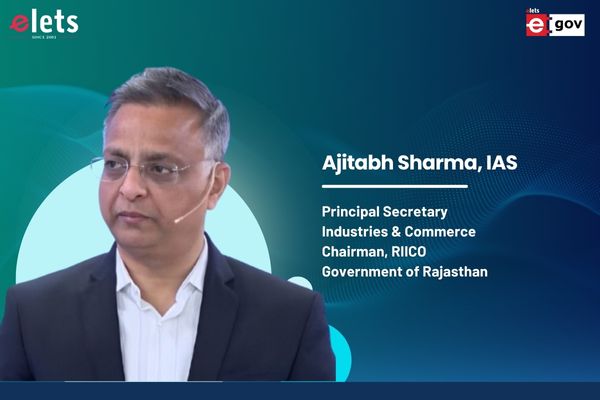
The Draft Master Plan 2041 prepared by the Yamuna Expressway Industrial Development Authority (YEIDA) outlines a comprehensive vision and strategy for the development of a sustainable, efficient, and globally recognized city in the vicinity of the Noida International Airport and along the Yamuna Expressway, shared Dr. Arun Vir Singh, IAS (Retd.), Chief Executive Officer (CEO), Yamuna Expressway Industrial Development Authority (YEIDA) & CEO, Noida International Airport (NIAL) in an exclusive interaction with Ritika Shrivastava & Srajan Agarwal of Elets News Network (ENN).
What are the key details of the third global tender floated by the YEIDA for the development of the International Film City?

Yamuna Expressway Industrial Development Authority (YEIDA) has floated a global tender for the third time to invite investors and production houses to develop, operate, and maintain the first phase of the International Film City in Sector 21, Noida using a Public Private Partnership (PPP) model. This tender focuses solely on the development of the first phase, covering 230 acres, a reduction from the initially proposed full project size of 1,000 acres due to past difficulties in attracting bidders because of the substantial investment required.

The first phase involves 155 acres for industrial use and 75 acres for commercial use, with the estimated investment reduced to around Rs 1,500 crore from the earlier Rs 7,200 crore for the entire project. Location of the the Film City is strategically chosen to be near the upcoming Noida International Airport in Jewar and close to the Eastern Peripheral Expressway. Boney Kapoor led company Bayview is the highest bidder for the film city project.

What are the expected benefits and key features of the green field airport development at Jewar, and how does it plan to enhance connectivity within the region?

The development of the green field airport at Jewar, as envisioned by the Government of Uttar Pradesh, is aimed at significantly improving industrialization and tourism in the region by connecting cities such as Agra, Mathura, Gautam Buddh Nagar, and others to the global aviation network. This initiative is expected to integrate the industries in the hinterland with the global value chains, thereby boosting the regional economy. Furthermore, the enhancement in air connectivity is anticipated to increase tourist inflow to existing sites and foster the development of new tourist centers, contributing to the growth of the tourism sector.
A key benefit of the proposed airport is the alleviation of congestion at the Indira Gandhi International (IGI) Airport in Delhi, which is nearing its capacity limits. The airport’s development is planned through a PPP model, with an initial phase featuring two runways by 2024, eventually expanding to a six-runway airport covering 11737 acres (4752 ha). The foundation stone for Jewar Airport was laid by Prime Minister Narendra Modi on 26 November 2021, with Zurich Airport International AG selected as the concessionaire/developer. Phase 1 of the project covers a site area of 1,334 hectares, with the airport expected to become operational in october 2024, ahead of IGI Airport reaching its threshold traffic handling capacity.
In terms of connectivity, the proposed site is strategically located to ensure easy access from the NCR region and various districts of western Uttar Pradesh. It is situated approximately 30 km from State Highway SH-22A, which connects Palwal to Aligarh, and is merely 700 meters away from the Yamuna Expressway. The airport’s southern side is planned to be linked to the proposed Palwal Khurja expressway. Additionally, the 100-meter-wide Eastern Peripheral Expressway, intersecting the Yamuna Expressway near the Formula One Track, will connect the site to key locations such as Palwal, Manesar, Ghaziabad, Baghpat, and Meerut, enhancing the overall accessibility and connectivity of the airport with the surrounding regions.
The airport will be connected to Yamuna express with Interchanges which will further connect Delhi-Mumbai express through Jevar-Ballavgarh green field connectrivity.
What are the key infrastructure components and development initiatives within the YEIDA region, and how do they support its vision of becoming a major economic and urban hub in Uttar Pradesh?
The key infrastructure components and development initiatives within the YEIDA region are strategically designed to support its vision of becoming a significant economic and urban hub in Uttar Pradesh. These components include the Yamuna Expressway itself, a 165-kilometer, 6-lane (expandable to 8 lanes) access-controlled expressway that enhances connectivity between Delhi and Agra and serves as the backbone for the region’s development. This expressway not only reduces travel time between major cities but also stimulates economic growth along its corridor.
YEIDA is being developed on approximately 25,000 hectares of land along the expressway and includes several ambitious projects. Among these are the Noida International Airport at Jewar, set to be India’s largest airport, the Buddh International Circuit (F1 Track), a sports city, an international cricket stadium, proposed largest Film City in India and Heritage City in Vrindavan. These projects are expected to transform the region into a vibrant economic zone, attracting investments and boosting tourism and entertainment industries.
The development of YEIDA is further supported by a comprehensive network of infrastructure projects such as the Golden Quadrilateral, Eastern Peripheral Expressway, and Western and Eastern Dedicated Freight Corridors (DFC), enhancing the region’s connectivity with major economic centers. The DMIC investment node nearby is another critical initiative, poised to promote industrial growth and urban development.
Utilities and services infrastructure is also a key focus in the YEIDA region. Water supply is ensured through various sources, including rivers, canals, and groundwater. The region benefits from the existing GAIL gas pipeline network, with future expansions planned to extend the gas grid to industrial areas, promoting clean energy use. Power supply initiatives are led by the presence of the NTPC Dadri Coal & Gas-based Power Plant, with further plans to enhance the region’s power infrastructure through the development of electric substations.
Together, these infrastructure components and development initiatives are pivotal in realizing YEIDA’s vision. They not only provide the necessary physical connectivity and utilities but also create a conducive environment for industrial, residential, and recreational developments, thereby positioning YEIDA as a key driver of economic growth and urban development in Uttar Pradesh.
Can you share insights regarding Draft Master Plan 2041 and the approach for achieving the vision and objectives mentioned in the plan?
The Draft Master Plan 2041 prepared by YEIDA outlines a comprehensive vision and strategy for the development of a sustainable, efficient, and globally recognized city in the vicinity of the Noida International Airport and along the Yamuna Expressway. This plan is designed to capitalize on the economic opportunities presented by the airport and the surrounding economic corridors, aiming to enhance the quality of life for its citizens while ensuring the region’s development is balanced, sustainable, and inclusive.
VISION
The vision of the Master Plan is to transform the YEIDA area into a sustainable, well-connected city that is recognized globally for its economic opportunities, particularly those surrounding the Noida International Airport. It aims to achieve high living standards for its residents through strategic development that emphasizes economic growth, environmental sustainability, and quality urban infrastructure.
OBJECTIVES
The Master Plan sets forth several key objectives to realize this vision:
- Economic and Employment Growth: By creating an Aerotropolis and fostering the development of cities within the city, the plan seeks to strengthen the economic base of the region and generate a surplus of employment opportunities. This involves leveraging the airport and expressway to attract investments and businesses.
- Quality and Affordable Infrastructure: It emphasizes the provision of high quality, affordable infrastructure to ensure a high standard of living. This includes access to essential services, utilities, and modern urban amenities.
- Sustainable Mobility: The plan aims to provide safe, reliable, economical, and environmentally friendly transportation options, integrating various modes of transport such as RRTS, buses, nonmotorized transport (NMT), cycle tracks, pedestrian pathways, and intermediate public transport (IPT).
- Cultural and Public Identity: Through the development of cultural venues and public spaces, the plan intends to create a unique identity for the city that promotes community engagement and cultural expression.
SALIENT FEATURES
To achieve these objectives, the Master Plan includes several features:
- Development of an appropriate urban form for a Greenfield city, including adequate space for airport city-side development and a balanced regional development that aligns with the regional plan.
- A high containment ratio to manage traffic demand within the city limits and sustainable development strategies for the new city and its surrounding urban centers.
- Flexibility in land use planning to adapt to market conditions, prioritization of affordable housing for industrial workers, and integration of public transport systems.
- Establishing a Central Commercial Centre with world-class infrastructure and an iconic pedestrian promenade, alongside facilities for heavy industrial traffic and logistics near the airport.
- Integration of existing villages into the urban fabric and creation of green buffers along natural features like the Yamuna River to preserve environmental integrity.
The Draft Master Plan 2041 for YEIDA is conceived as a dynamic blueprint for urban development, focusing on industrial growth supported by knowledge-based institutions, and residential, commercial, and recreational facilities. Its location along the Yamuna Expressway, connecting major tourist and economic hubs like Agra and Delhi, positions it uniquely for development that leverages regional advantages while prioritizing sustainability and inclusivity. The plan underscores the importance of preserving environmentally sensitive areas even as it promotes economic and urban development, aiming for a balanced approach that fosters growth and enhances the quality of life for its citizens.
Be a part of Elets Collaborative Initiatives. Join Us for Upcoming Events and explore business opportunities. Like us on Facebook , connect with us on LinkedIn and follow us on Twitter, Instagram.
"Exciting news! Elets technomedia is now on WhatsApp Channels Subscribe today by clicking the link and stay updated with the latest insights!" Click here!













